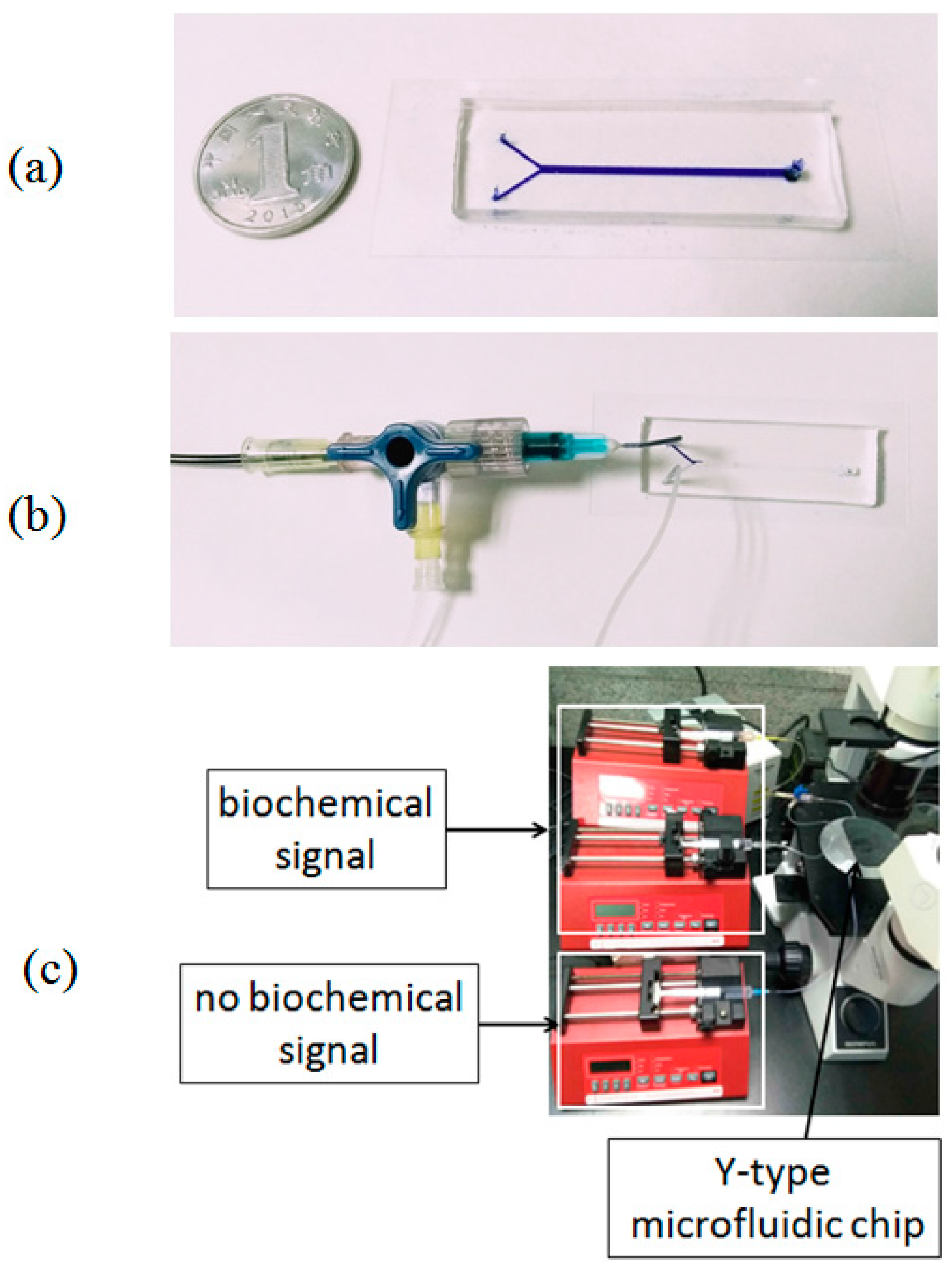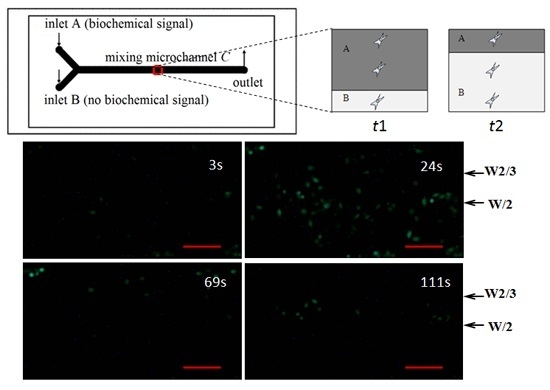A Y-Shaped Microfluidic Device to Study the Combined Effect of Wall Shear Stress and ATP Signals on Intracellular Calcium Dynamics in Vascular Endothelial Cells
Abstract
:1. Introduction
2. Materials and Methods
2.1. Equations Governing Pulsatile Flow and Mass Transfer
2.1.1. Equation Governing Pulsatile Flow in the Mixing Micro-Channel C
2.1.2. Control of Two-Stream Flow Widths in the Mixing Micro-Channel C
2.1.3. Taylor-Aris Dispersion in the Mixing Micro-Channel C
2.2. Microfluidic Device Fabrication and Experimental Setup
2.3. Generation of Dynamic Biochemical Signals
2.4. Transport of Dynamic Biochemical Signals in the Mixing Micro-Channel C
2.4.1. Numerical Simulation
2.4.2. Experimental Validation
2.5. Cell Culture and Intracellular Calcium Dynamic Response
3. Results
3.1. Spatiotemporal Profiles of Static and Dynamic Fluorescent Signals in the Mixing Micro-Channel C
3.2. Combination of WSS and Fluorescent Signals at the Central Regime Along the Mixing Micro-Channel C
3.3. Intracellular Ca2+ Dynamics in Huvecs in Response to Combined Effects of WSS and ATP Signals
4. Discussion
5. Conclusions
Acknowledgments
Author Contributions
Conflicts of Interest
Abbreviations
| WSS | Wall shear stress |
| ATP | Adenosine triphosphate |
| VECs | Vascular endothelial cells |
| D | Diffusivity of solute (m2/s) |
| Deff | Effective diffusivity coefficient of solute (m2/s) |
| H | Height of the mixing micro-channel (m) |
| p | Pressure (Pa) |
| Q | Total flow rate in the mixing micro-channel C (mL/h) |
| QA | Flow rate at inlet A (mL/h) |
| QB(t) | Flow rate at inlet B (mL/h) |
| u | Velocity of fluid in z direction (m/s) |
| W | Width of the mixing micro-channel (m) |
| W1 | Width of solution A in the mixing micro-channel (m) |
| W2 | Width of solvent B in the mixing micro-channel (m) |
| ε(t) | Ratio of W2 to W |
| η | Viscosity of fluid (Pa·s) |
| Concentration of solution in the micro-channel (μmol/mL) | |
| Height-wise averaging concentration of solution (μmol/mL) | |
| Height-wise averaging concentration of solution at inlet A (μmol/mL) | |
| Wall shear stress (Pa) |
References
- Ando, J.; Ohtsuka, A.; Korenaga, R.; Kamiya, A. Effect of extracellular ATP level on flow-induced Ca++ response in cultured vascular endothelial cells. Biochem. Biophys. Res. Commun. 1991, 179, 1192–1199. [Google Scholar] [CrossRef]
- Ando, J.; Kamiya, A. Cytoplasmic calcium response to fluid shear stress in cultured vascular endothelial cells. In Vitro Cell. Dev. Biol. 1988, 24, 871–877. [Google Scholar] [CrossRef] [PubMed]
- Dull, R.O.; Davies, P.F. Flow modulation of agonist (ATP)-response (Ca2+) coupling in vascular endothelial cells. Am. J. Physiol. 1991, 261, 149–154. [Google Scholar]
- Mo, M.; Eskin, S.G.; Schilling, W.P. Flow-induced changes in Ca2+ signaling of vascular endothelial cells: Effect of shear stress and ATP. Am. J. Physiol. 1991, 260, 1698–1707. [Google Scholar]
- Yamamoto, K.; Korenaga, R.; Kamiya, A.; Ando, J. Fluid shear stress activates Ca2+ influx into human endothelial cells via P2X4 purinoceptors. Circ. Res. 2000, 87, 385–391. [Google Scholar] [CrossRef] [PubMed]
- Yamamoto, K.; Korenaga, R.; Kamiya, A.; Qi, Z.; Sokabe, M.; Ando, J. P2X4 receptors mediate ATP-induced calcium influx in human vascular endothelial cells. Am. J. Physiol. Heart Circ. 2000, 279, 285–292. [Google Scholar]
- Yamamoto, K.; Sokabe, T.; Ohura, N.; Nakatsuka, H.; Kamiya, A.; Ando, J. Endogenously released ATP mediates shear stress-induced Ca2+ influx into pulmonary artery endothelial cells. Am. J. Physiol. Heart Circ. 2003, 285, 793–803. [Google Scholar] [CrossRef] [PubMed]
- Shen, J.; Luscinskas, F.W.; Gimbrone, M.A.; Dewey, C.F. Fluid flow modulates vascular endothelial cytosolic calcium responses to adenine nucleotides. Microcirculation 1994, 1, 67–78. [Google Scholar] [CrossRef] [PubMed]
- James, N.L.; Harrison, D.G.; Nerem, R.M. Effects of shear on endothelial cell calcium in the presence and absence of ATP. FASEB J. 1995, 9, 968–973. [Google Scholar] [PubMed]
- Helmlinger, G.; Berk, B.C.; Nerem, R.M. Pulsatile and steady flow-induced calcium oscillations in single cultured endothelial cells. J. Vasc. Res. 1996, 33, 360–369. [Google Scholar] [CrossRef] [PubMed]
- Li, L.F.; Xiang, C.; Qin, K.R. Modeling of TRPV4-C1-mediated calcium signaling in vascular endothelial cells induced by fluid shear stress and ATP. Biomech. Model. Mechanbiol. 2015, 14, 979–993. [Google Scholar] [CrossRef] [PubMed]
- Davies, P.F. Flow-mediated endothelial mechanotransduction. Physiol. Rev. 1995, 75, 519–560. [Google Scholar] [PubMed]
- Berridge, M.J.; Lipp, P.; Bootman, M.D. The versatility and universality of calcium signaling. Nat. Rev. Mol. Cell Biol. 2000, 1, 11–21. [Google Scholar] [CrossRef] [PubMed]
- Clapham, D.E. Calcium signaling. Cell 1995, 80, 259–268. [Google Scholar] [CrossRef]
- Bibhas, R.; Tamal, D.; Debasish, M.; Maiti, T.K.; Chakraborty, S. Oscillatory shear stress induced calcium flickers in osteoblast cells. Integr. Biol. 2014, 6, 289–299. [Google Scholar]
- Yamada, A.; Katanosaka, Y.; Mohri, S.; Naruse, K. A rapid microfluidic switching system for analysis at the single cellular level. IEEE Trans. Nanobiosci. 2009, 8, 306–311. [Google Scholar] [CrossRef] [PubMed]
- Kuczenski, B.; Ruder, W.C.; Messner, W.C.; Leduc, P.R. Probing cellular dynamics with a chemical signal generator. PLoS ONE 2009, 4, e4847. [Google Scholar] [CrossRef] [PubMed]
- Zhang, X.; Grimley, A.; Bertram, R.; Roper, M.G. Microfluidic system for generation of sinusoidal glucose waveforms for entrainment of islets of Langerhans. Anal. Chem. 2010, 82, 6704–6711. [Google Scholar] [CrossRef] [PubMed]
- Kim, Y.T.; Joshi, S.D.; Messner, W.C.; LeDuc, P.R.; Davidson, L.A. Detection of dynamic spatiotemporal response to periodic chemical stimulation in a Xenopus Embryonic tissue. PLoS ONE 2011, 6, e14624. [Google Scholar] [CrossRef] [PubMed]
- Shin, H.; Mahto, S.K.; Kim, J.H.; Rhee, S.W. Exposure of BALB/3T3 fibroblast cells to temporal concentration profile of toxicant inside microfluidic device. Biochip J. 2011, 5, 214–219. [Google Scholar] [CrossRef]
- Wang, Y.X.; Xiang, C.; Liu, B.; Zhu, Y.; Luan, Y.; Liu, S.T.; Qin, K.R. A multi-component parallel-plate flow chamber system for studying the effect of exercise-induced wall shear stress on endothelial cells. Biomed. Eng. 2016. submitted for publication. [Google Scholar]
- Li, Y.J.; Li, Y.Z.; Cao, T.; Qin, K.R. Transport of dynamic biochemical signals in steady flow in a shallow Y-shaped microfluidic channel: Effect of transverse diffusion and longitudinal dispersion. J. Biomech. Eng. 2013, 135, 121011–121019. [Google Scholar] [CrossRef] [PubMed]
- Qin, K.R.; Xiang, C.; Ge, S.S. Generation of dynamic biochemical signals with a tube mixer: Effect of dispersion in an oscillatory flow. Heat Mass Transf. 2010, 46, 675–686. [Google Scholar] [CrossRef]
- Xie, Y.; Wang, Y.; Mastrangelo, C.H. Fourier microfluidics. Lab Chip 2008, 8, 779–785. [Google Scholar] [CrossRef] [PubMed]
- Capretto, L.; Cheng, W.; Hill, M.; Zhang, X. Micromixing within microfluidic devices. Top. Curr. Chem. 2011, 304, 27–68. [Google Scholar] [PubMed]
- Nguyen, N.T.; Wu, Z. Micromixers—A review. J. Micromech. Microeng. 2005, 15, 1–16. [Google Scholar] [CrossRef]
- Furdui, V.I.; Harrison, D.J. Immunomagnetic T cell capture from blood for PCR analysis using microfluidic systems. Lab Chip 2004, 4, 614–618. [Google Scholar] [CrossRef] [PubMed]
- Mazutis, L.; Gilbert, J.; Ung, W.L.; Weitz, D.A.; Griffiths, A.D.; Heyman, J.A. Single-cell analysis and sorting using droplet-based microfluidics. Nat. Protoc. 2013, 8, 870–891. [Google Scholar] [CrossRef] [PubMed]
- Yamada, M.; Nakashima, M.; Seki, M. Pinched flow fractionation: Continuous size separation of particles utilizing a laminar flow profile in a pinched microchannel. Anal. Chem. 2004, 76, 5465–5471. [Google Scholar] [CrossRef] [PubMed]
- Malek, A.M.; Zhang, J.; Jiang, J.; Alper, S.L.; Izumo, S. Endothelin-1 gene suppression by shear stress: Pharmacological evaluation of the role of tyrosine kinase, intracellular calcium, cytoskeleton, and mechanosensitive channels. J. Mol. Cell. Cardiol. 1999, 31, 387–399. [Google Scholar] [CrossRef] [PubMed]
- Kanai, A.J.; Strauss, H.C.; Truskey, G.A.; Crews, A.L.; Grunfeld, S.; Malinski, T. Shear stress induces ATP-independent transient nitric oxide release from vascular endothelial cells, measured directly with a porphyrinicmicrosensor. Circ. Res. 1995, 77, 284–293. [Google Scholar] [CrossRef] [PubMed]








| Parameters | Values |
|---|---|
| L (z-direction) | 4 cm |
| H (y-direction) | 80 μm |
| W (x-direction) | 1000 μm |
| η | 0.001 Pa·s |
| Dfluorescent | 8.2 × 10−10 m2/s |
| DATP | 2.36 × 10−10 m2/s |
© 2016 by the authors. Licensee MDPI, Basel, Switzerland. This article is an open access article distributed under the terms and conditions of the Creative Commons Attribution (CC-BY) license ( http://creativecommons.org/licenses/by/4.0/).
Share and Cite
Chen, Z.-Z.; Gao, Z.-M.; Zeng, D.-P.; Liu, B.; Luan, Y.; Qin, K.-R. A Y-Shaped Microfluidic Device to Study the Combined Effect of Wall Shear Stress and ATP Signals on Intracellular Calcium Dynamics in Vascular Endothelial Cells. Micromachines 2016, 7, 213. https://doi.org/10.3390/mi7110213
Chen Z-Z, Gao Z-M, Zeng D-P, Liu B, Luan Y, Qin K-R. A Y-Shaped Microfluidic Device to Study the Combined Effect of Wall Shear Stress and ATP Signals on Intracellular Calcium Dynamics in Vascular Endothelial Cells. Micromachines. 2016; 7(11):213. https://doi.org/10.3390/mi7110213
Chicago/Turabian StyleChen, Zong-Zheng, Zheng-Ming Gao, De-Pei Zeng, Bo Liu, Yong Luan, and Kai-Rong Qin. 2016. "A Y-Shaped Microfluidic Device to Study the Combined Effect of Wall Shear Stress and ATP Signals on Intracellular Calcium Dynamics in Vascular Endothelial Cells" Micromachines 7, no. 11: 213. https://doi.org/10.3390/mi7110213
APA StyleChen, Z.-Z., Gao, Z.-M., Zeng, D.-P., Liu, B., Luan, Y., & Qin, K.-R. (2016). A Y-Shaped Microfluidic Device to Study the Combined Effect of Wall Shear Stress and ATP Signals on Intracellular Calcium Dynamics in Vascular Endothelial Cells. Micromachines, 7(11), 213. https://doi.org/10.3390/mi7110213







